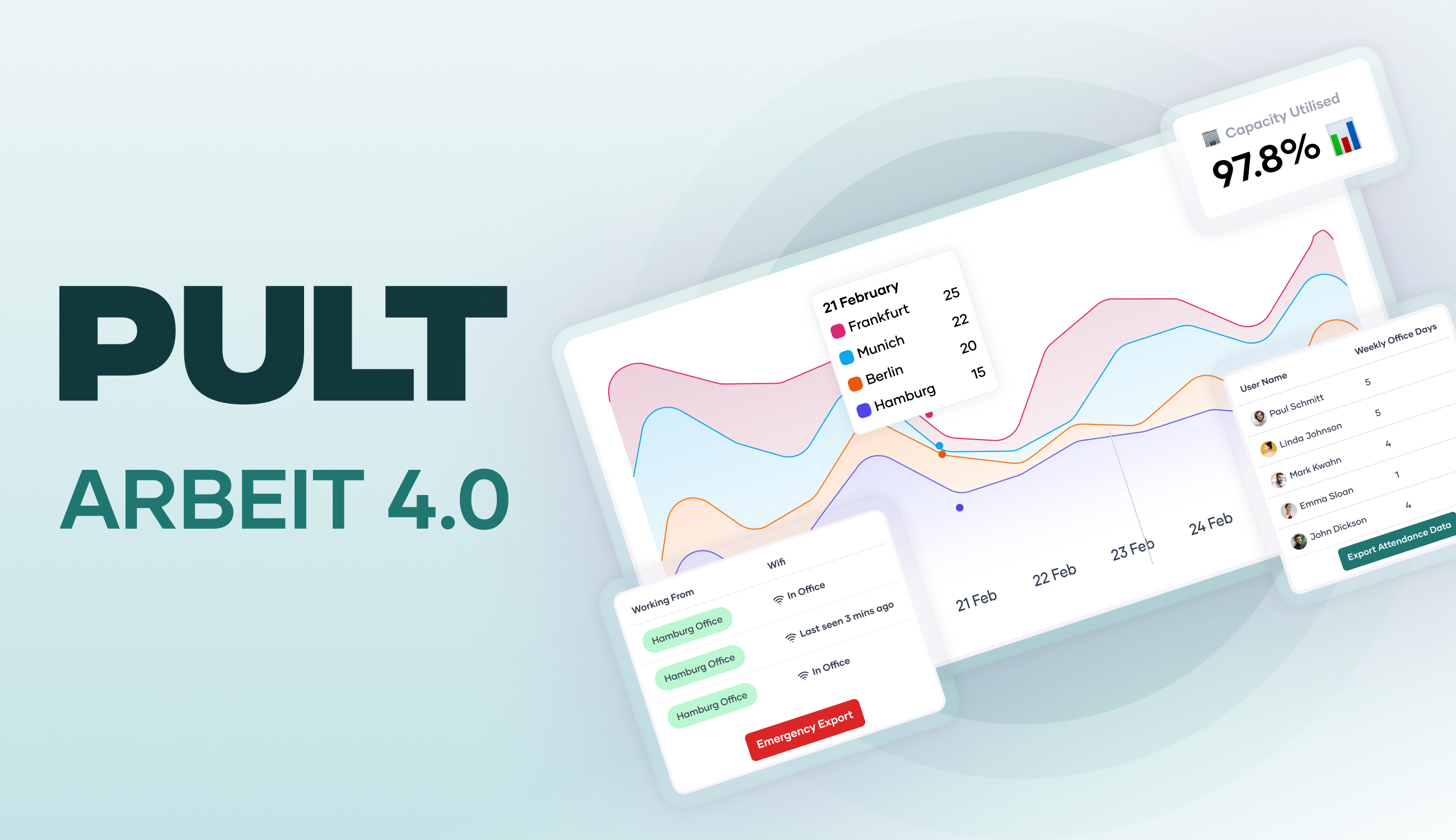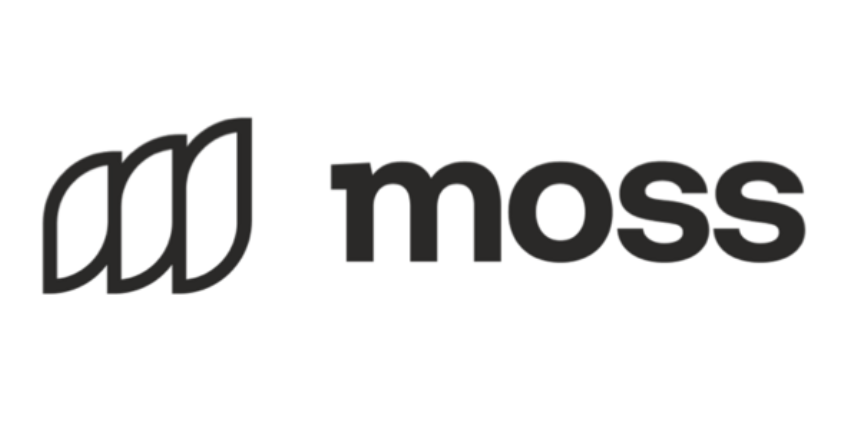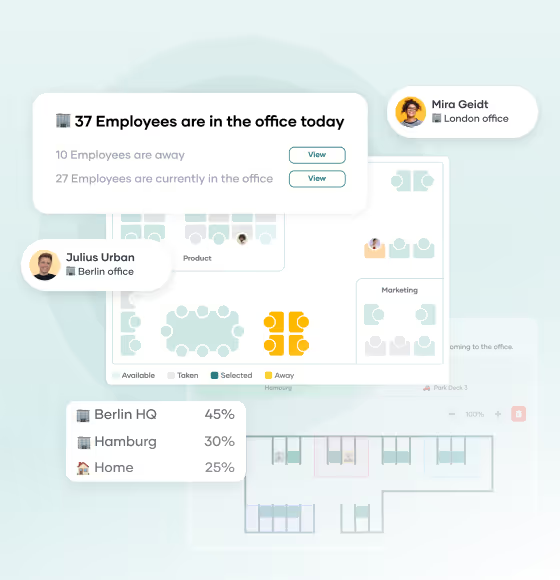Work 4.0: How digitalization, AI, and new ways of working are shaping the future of work

Work 4.0: TL;DR
- Digitally networked: Communication, data, and processes are cloud-based and run in real time.
- Location-independent: Teams work in a hybrid manner, i.e., in the office, from home, or on the road, depending on the task and individual productivity.
- New skill profiles: Digital, social, and self-organizational skills are becoming increasingly important. Routine tasks are being automated.
- Law & responsibility: Working time, data protection, and occupational safety regulations must be adapted to more flexible working models.
- Office space in transition: Traditional desks are giving way to modular, shared work zones, controlled via a booking system (PULT).
- Leadership & culture: Trust, results orientation, and increased communication are replacing pure presence control.
What is Work 4.0?
Work 4.0 (also known as “labor 4.0” or “Arbeit 4.0”) describes the transformation of work through digitalization, networking, and the use of automation and artificial intelligence. The term ties in with Industry 4.0 technologies, but shifts the focus from production processes to forms of work, organization, and employment relationships.
- Work 1.0: Mechanization; factory work emerges.
- Work 2.0: Electrification & assembly lines; mass production.
- Work 3.0: IT & early automation; global networking begins.
- Work 4.0: Real-time networking, cloud, AI, platform work, hybrid models: work becomes more flexible in terms of location and time.
What are the characteristics of Work 4.0?
Work 4.0 stands for the interplay of digitalization, automation, and personal freedom of choice. It is changing where, when, and how people work: through digital workplaces, location-independent collaboration, artificial intelligence, and new forms of leadership.
The digital and changing workplace
Work is becoming decoupled from the physical office. Documents, communication, and processes run in the cloud and are therefore accessible anytime, anywhere. Chats, video meetings, and project software are becoming the most important work tools.
Employees are increasingly organizing their work independently, and the task determines the place of work. This applies both to the choice between the office and working from home, as well as to the choice of the right workplace within the office. In addition to traditional individual workstations, there are also zones for collaboration, quiet zones for concentrated work, and areas for personal balance.
Management and learning culture
Employee management is changing from control to coaching and trust. Performance is measured by results, not by presence.
At the same time, a willingness to engage in lifelong learning is becoming an important characteristic: skills in software and AI, self-organization, and adaptability to new technologies are of great importance in Work 4.0.
Working hours
In many countries, employers are required to keep complete records of working hours. Companies use digital time recording systems for this purpose. These automatically record the start of work, breaks, and the end of work, even when working from home. At the same time, the four-day week and working time accounts are becoming established, allowing overtime and reduced working hours to be balanced out over longer periods.
Regulations against blurring boundaries
A frequent conflict amid the otherwise very free Work 4.0 is availability outside regular working hours. Works agreements now stipulate that emails or chat messages outside core working hours do not have to be answered. This ensures that working time limits are adhered to despite digital networking.
What technologies shape Work 4.0?
Work 4.0 is primarily defined by automation, artificial intelligence, cloud infrastructures, data analysis, and networked workplace systems. These technologies make it possible to digitally map, control, and evaluate all or as many processes as possible.
Automation and robotics
Automation means that technical systems perform recurring tasks independently. Many companies already use software systems that take over routine tasks:
For example, they read invoices, compare amounts with orders, and automatically forward them to approval processes. In human resources or contract management, programs recognize deadlines and generate reminders without anyone having to check manually.
Automation is also already widespread in production and corresponds to the image of Work 4.0. Robots take over monotonous assembly steps, high-resolution cameras check surfaces for defects, and driverless transport systems bring materials to the right place at the right time.
Artificial intelligence
Artificial intelligence (AI) extends automation with the ability to understand data and draw conclusions from it. It is used to recognize patterns and process or generate language or images.
AI is used to automatically assign topics to incoming emails, transcribe meeting notes, or detect irregularities in production data. In service departments, AI systems analyze inquiries and suggest appropriate response modules or solutions.
In human resources, they help with the pre-selection of applications by evaluating resumes in a structured manner and comparing requirements with job data.
Such systems do not make decisions, but rather deliver interim results. Humans then review, correct, and approve them. This changes the role of many employees: they control automated processes instead of executing them entirely themselves.
Data and analytics
Digitalization generates large amounts of usage and performance data. Evaluating this data is an essential basis for Work 4.0.
Companies collect anonymized data on how workstations, rooms, or systems are used. Booking times, check-ins, room occupancy, or sensor data on air quality show when workstations, zones, and rooms are actually being used.
This is supplemented by performance data from processes, such as throughput times, error rates, or processing times for transactions.
Patterns can be derived from this information: on which days offices are heavily occupied, which room sizes are used too often or too rarely, or where approval processes regularly come to a standstill.
Based on such analyses, work organization, space planning, or shift models can be adapted to actual requirements.
Tip: In PULT, you can measure office utilization without sensors. With the data obtained, you can gradually replan your office space and provide your employees with the resources they really need.
Augmented and virtual reality
Augmented reality (AR) and virtual reality (VR) complement Work 4.0 with immersive forms of learning and application.
In maintenance, technicians can use AR glasses to see step-by-step instructions directly in their field of vision. In the event of complex malfunctions, experts can be called in via video function and markings can be placed in the image.
VR simulations are used in education and training to practice procedures safely, such as safety procedures, machine operation, or emergency scenarios. VR is also used in design to virtually walk through facilities or office spaces and check ergonomic aspects in advance.
Networked workplace and building technology
In offices that meet the requirements of Work 4.0, sensors and IoT (Internet of Things) systems ensure that buildings and building technology actively respond to usage.
Motion and occupancy sensors detect which workstations or meeting rooms are occupied. CO₂ and temperature measurements control ventilation and air conditioning. Lighting and cleaning can thus be adapted to actual usage.
How are the location and time of Work 4.0 changing?
Work 4.0 is changing the organization of location and time. Work is less tied to a fixed place or a rigid schedule. It takes place where tasks can be completed efficiently and at times that suit both operational processes and employees' personal planning.
Transition from a fixed workplace to a flexible concept
The office is supplemented by other work locations, and employees switch between the company, their home office, and third work locations such as coworking spaces. As a result, the entire team is no longer in the office every day.
As a result, individual workstations are being eliminated. They are giving way to a desk sharing concept that continues to provide a reduced number of individual workstations. These are booked before the start of work and are therefore reserved on a binding basis.
Desk sharing means that less office space is taken up by individual workstations. This creates more space for resources that are in greater demand: meeting rooms, zones for teamwork, and areas for relaxation and recreation. These rooms and zones can also be created and booked in PULT.
In this way, desk sharing makes the office suitable for activity-based working. Your employees decide for themselves which location, room, or zone is best suited to the task at hand on a given day.
Working time models under Work 4.0
Freedom of choice in terms of location goes hand in hand with freedom of choice in terms of time. Working hours are increasingly based on results rather than fixed time slots.
Flexitime, trust-based working hours, and annual working time accounts are common models for balancing personal and operational requirements.
What skills do employees need in Work 4.0?
Work 4.0 requires employees to have new and expanded skills in dealing with technology, data, and self-organization. Important skills include knowledge of cloud software and AI, analytical thinking, personal responsibility, and the ability to adapt to change.
Dealing with data and information
Aspects of data analysis are finding their way into many activities. Key figures are displayed directly in the work process, for example in the dashboard in production or in the ticket monitor in customer service.
Employees must be able to read these key figures and results, check their significance, and know what they should decide themselves and when they should ask questions.
Example: An increase in processing time may indicate technical problems or that a team is currently working on more complex orders.
Self-organization and stress management
With the spread of working from home, flexitime, and trust-based working hours, responsibility for work organization is shifting to the individual. If your employees frequently switch between the office and working from home, they need to plan their own tasks, limit interruptions, and draw boundaries between work and leisure time.
Self-organization is also a matter of health and well-being. Studies by the BAuA show that employees who work from home report longer screen times more frequently. That's why the ability to schedule breaks, limit availability, and recognize overload in good time is also one of the skills in demand.
Long-distance communication
Digital collaboration requires understanding and benevolent communication. In video conferences or chat messages, body language and nuances are missing, and misunderstandings arise more easily. Successful teams therefore take care to record agreements in writing, document decisions openly, and allow questions at any time.
In industry 4.0 and skilled trades, too, coordination is increasingly being carried out digitally, for example between field staff and office staff, for example via apps.
Willingness to learn and adaptability
According to the Future of Jobs Report 2025, around 39 percent of professional qualifications worldwide will change within five years. This means that knowledge is becoming obsolete faster than traditional continuing education can replace it.
The ability to learn is therefore considered a new core competency. This includes curiosity, acceptance of mistakes, and a willingness to familiarize oneself with new topics.
Tip: With PULT, the software for workplace booking and office insights, you can work in compliance with GDPR. You receive comprehensive evaluations of office usage, and since no conclusions can be drawn about the behavior of individual persons, data protection remains unaffected.
Shaping Work 4.0 with PULT
The Work 4.0 workplace is the result of several factors working together:
- Spaces and zones that cater to different ways of working.
- Technology, software, and AI that take care of routine tasks and function reliably.
- Employees who are ready for change and develop future-proof skills.
- A culture that ensures people feel comfortable in the office.
To ensure that you can approach the process of Work 4.0 in your company not just based on gut feeling, but in a targeted manner, you need reliable data, such as that provided by PULT:
- Office Insights: In PULT, you can see in real time how heavily your office space, rooms, and workstations are being used. Based on this, you can plan your space in line with the new requirements of Work 4.0.
- PULT Presence: In addition to booking data, Presence provides you with real attendance figures. As soon as laptops or smartphones connect to the company Wi-Fi, office attendance is automatically recorded. This gives you a realistic picture of how many employees are actually in the office, regardless of whether they have made a booking in advance.
- Workstation and room booking: Your employees can reliably reserve workstations, meeting rooms, zones, and parking spaces. This ensures that everyone has fair access to existing and newly created resources and that no one is left standing in front of occupied spaces.
{{onpage-cta}}
What distinguishes Work 4.0 from New Work?
Work 4.0 describes the technological and organizational change brought about by digitalization, automation, and AI. New Work refers more to values, motivation, and self-determination in the world of work. Both developments are intertwined, but have different focuses.
Does Work 4.0 mean that jobs will be lost?
Some routine tasks will be automated, but at the same time new areas of responsibility will emerge, for example in data analysis, process control, and IT security. Studies by the World Economic Forum predict net job growth by 2030 if training is successful.
How can companies prepare their employees for Work 4.0?
Through targeted training in personal responsibility and AI skills, as well as by developing a corporate culture that rewards learning and participation. Training courses on cloud software and AI, data protection, and self-organization are a good place to start.
How is Work 4.0 changing team leadership?
Leadership is becoming less control-oriented and more coordinating. Trust, clear goals, and good communication are becoming more important. Continuous and long attendance as a performance criterion is losing importance.
A new hybrid workplace experience is coming. Start Now. 🎉
Offer your employees the workplace of the future. Get started with PULT now.





















.avif)




